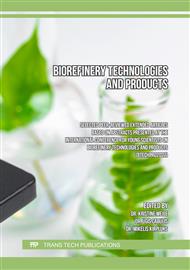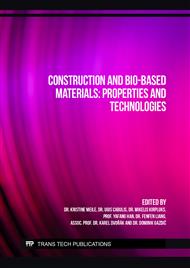[1]
B. C. Gibb, Plastics are forever, Nature Chemistry, 2019, Vol 11, 394-395.
Google Scholar
[2]
R. Geyer, J. R. Jambeck, K. L. Law, Production, use, and fate of all plastics ever made, Science Advances, 2017, Vol 3, 7.
DOI: 10.1126/sciadv.1700782
Google Scholar
[3]
A. Chamas, H. Moon, J. Zheng, Y. Qiu, T. Tabassum, J. H. Jang, M. Abu-Omar, S. L. Scott, S. Suh, Degradation Rates of Plastics in the Environment, ACS Sustainable Chemistry & Engineering, 2020, 8(9), 3494-3511.
DOI: 10.1021/acssuschemeng.9b06635
Google Scholar
[4]
S. M. Al-Salem, P. Lettieri, J. Baeyens, Recycling and recovery routes of plastic solid waste (PSW): A review, Science Direct, 2009, 29(10), 2625-2643.
DOI: 10.1016/j.wasman.2009.06.004
Google Scholar
[5]
H. Alhazmi, F. H. Almansour, Z. Aldhafeeri Plastic Waste Management: A Review of Existing Life Cycle Assessment Studies, sustainability, 2021, 13, 5304.
DOI: 10.3390/su13105340
Google Scholar
[6]
A. L. Andrady, Microplastics in the marine environment, Marine Pollution Bulletin, 2011, 62(8), 1596-1605.
DOI: 10.1016/j.marpolbul.2011.05.030
Google Scholar
[7]
K. Pozo, W. Urbina, V. Gómez, M. Torres, D. Nuñez, P. Přibylová, O. Audy, B. Clarke, A. Arias, N. Tombesi, Y. Guida, J. Klánová, Persistent organic pollutants sorbed in plastic resin pellet — Nurdles, from coastal areas of Central Chile, Marine Pollution Bulletin, 2020, Vol 151, 110786.
DOI: 10.1016/j.marpolbul.2019.110786
Google Scholar
[8]
More information: https://sdgs.un.org/goals.
Google Scholar
[9]
M. Jones, T. Bhat, T. Huynh, E. Kandare, R. Yuen, C. H. Wang, S. John, Waste-derived low-cost mycelium composite construction materials with improved fire safety, Fire and Materials, 2018, (42) 816-825.
DOI: 10.1002/fam.2637
Google Scholar
[10]
Z. Zimele, I. Irbe, J. Grinins, O. Bikovens, A. Verovkins, D. Bajare, Novel Mycelium-Based Biocomposites (MBB) as Building Materials, Journal of Renewable Materials, 2020, 8(9), 1067-1076.
DOI: 10.32604/jrm.2020.09646
Google Scholar
[11]
E. Elsacker, S. Vandelook, J. Brancart, E. Peeters, L. De Laet, Mechanical, physical and chemical characterisation of mycelium-based composites with different types of lignocellulosic substrates, Plos One, 2019, 14, 7.
DOI: 10.1371/journal.pone.0213954
Google Scholar
[12]
N. Attias, O. Danai, T. Abitbol, E. Tarazi, N. Ezov, I. Pereman, Y. J. Grobman, Mycelium bio-composites in industrial design and architecture: Comparative review and experimental analysis, Journal of Cleaner Production, Vol 246, 2020, 119037.
DOI: 10.1016/j.jclepro.2019.119037
Google Scholar
[13]
F. V.W. Appels, S. Camere, M. Montalti, E. Karana, K. M.B. Jansens, J. Dijksterhuis, P. Krijgsheld, H. A.B. Wösten, Fabrication factors influencing mechanical, moisture- and water-related properties of mycelium-based composites, Materials & Design, Vol 161, 2019, 64-71.
DOI: 10.1016/j.matdes.2018.11.027
Google Scholar
[14]
F. V.W. Appels, J. Dijksterhuis, Lukasiewicz C.E., K. M.B. Jansen, H. A.B. Wösten, P. Krijgsheld, Hydrophobin gene deletion and environmental growth conditions impact mechanical properties of mycelium by affecting the density of the material, Scientific Reports, 8, 4703.
DOI: 10.1038/s41598-018-23171-2
Google Scholar
[15]
W. Sun, M. Tajvidi, C. G. Hunt, G. McIntyre, D. J. Gardner, Fully Bio-Based Hybrid Composites Made of Wood, Fungal Mycelium and Cellulose Nanofibrils, Scientific Reports, 2019, (9) 3766.
DOI: 10.1038/s41598-019-40442-8
Google Scholar
[16]
More information: https://zeltabele.mozello.lv/produkti/.
Google Scholar
[17]
D. C. Sauder, C. E. DeMars, An Updated Recommendation for Multiple Comparisons. Advances in Methods and Practices in Psychological Science, 2019, 2(1), 26-44.
DOI: 10.1177/2515245918808784
Google Scholar
[18]
J. Rizikovs, A. Paze, A. Plavniece, K. Stankus, I. Virsis, A novel method for birch outer bark quality control using higher heating value, Proceedings of the 11th International Scientific and Practical Conference, 2017, (3) 282-285.
DOI: 10.17770/etr2017vol3.2550
Google Scholar
[19]
I. Makarov, M. Vinogradov, T. Gromovykh, S. Lutsenko, N. Feldman, G. Shambilova, V. Sadykova, Antifungal Composite Fibers Based on Cellulose and Betulin, Fibers, 2018, (6) 23.
DOI: 10.3390/fib6020023
Google Scholar
[20]
I. Irbe, J. Grinins, Z. Zimele, Wood composites vs mycelium composites – water absorbtion and mould growth properties, 9th Hardwood Conference Proceedings., 2020, 9 (1) 121-127.
Google Scholar
[21]
M. Jones, A. Mautner, S. Luenco, A. Bismarck, S. John, Engineered mycelium composite construction materials from fungal biorefineries: A critical review, Materials & Design, 2020, Vol 187, 108397.
DOI: 10.1016/j.matdes.2019.108397
Google Scholar
[22]
Y. Jiang, M. Lawrence, M. P. Ansell, A. Hussain, Cell wall microstructure, pore size distribution and absolute density of hemp shiv. Royal Society Open Science, 2018, (5), 171 945.
DOI: 10.1098/rsos.171945
Google Scholar
[23]
I. Y. Gnip, V. Kersulis, S. Vejelis, S. Vaitkus, Water absorption of expanded polystyrene boards, Polymer Testing, 2006, 5, 635-641.
DOI: 10.1016/j.polymertesting.2006.04.002
Google Scholar
[24]
J. Graça, Suberin: The biopolyester at the frontier of plants, Frontiers of Chemistry, 2015, 3, 62.
Google Scholar
[25]
R. L. Gautam, R. Naraian, Trichoderma, a Factory of Multipurpose Enzymes: Cloning of Enzymatic Genes. Fungal Biotechnology and Bioengineering, 2020, 137-162.
DOI: 10.1007/978-3-030-41870-0_5
Google Scholar
[26]
Y. Zhang, B. Tang, G. Du, Production of Cellulases by Rhizopus stolonifer from Glucose-Containing Media Based on the Regulation of Transcriptional Regulator CRE, Journal of Microbiology and Biotechnology, 2017, 27(3), 514-523.
DOI: 10.4014/jmb.1608.08048
Google Scholar
[27]
S. Rogawansamy, S. Gaskin, M. Taylor, D. Pisaniello, An Evaluation of Antifungal Agents for the Treatment of Fungal Contamination in Indoor Air Environments, International Journal of Environmental Research and Public Health, 2015, 12, 6319-6332.
DOI: 10.3390/ijerph120606319
Google Scholar
[28]
C. J. Rabie, A. Lübben, M. A.A. Schipper, F. R.van Heerden, J. E. Fincham, Toxigenicity of Rhizopus species, International Journal of Food Microbiology, 1985, 1(5), 263-270.
DOI: 10.1016/0168-1605(85)90018-2
Google Scholar
[29]
J. Jennessen, K. F. Nielsen, J. Houbraken, E. K. Lyhne, J. Schnürer, J. C. Frisvad, A. A. Sams, Secondary Metabolite and Mycotoxin Production by the Rhizopus microsporus Group, Journal of Agricultural and Food Chemistry, 2005, 55, 1833-1840.
DOI: 10.1021/jf048147n
Google Scholar
[30]
M. M.A. Mansour, M. Z.M. Salem, R. R.A Hassan, H.M. Ali, F. Al, M. S. Elshikh, Antifungal potential of three natural oils and their effects on the thermogravimetric and chromatic behaviors when applied to historical paper and various commercial paper sheets, BioResources, 16(1), 492-514.
DOI: 10.15376/biores.16.1.492-514
Google Scholar
[31]
W. Yingprasert, N. Matan, N. Matan, Effects of surface treatment with cinnamon oil and clove oil on mold resistance and physical properties of rubberwood particleboards, Europeen Journal of Wood and Wood Products, 2014, 73, 103-109.
DOI: 10.1007/s00107-014-0857-x
Google Scholar
[32]
J.N.V. Latha, P. N. Babu, P. Rakesh, K. A. Kumar, M. Anupama, L. Susheela, Fungal Cell Walls as Protective Barriers for Toxic Metals, Advances in Medicine and Biology, Vol 53.
Google Scholar
[33]
T. Mester, E. Varela, M. Tien, Wood degradation by Brown-Rot and White-Rot Fungi, Genetics and Biotechnology, 2004, MYCOTA, Vol 2, 355-368.
DOI: 10.1007/978-3-662-07426-8_17
Google Scholar
[34]
R.C. Babu, H. Ketanapalli, S.K. Beebi, V.C. Kolluru, Wheat Bran – Composition and Nutritional Quality: A Review. Advances in Biotechnology & Microbiology, 2018, Vol 9, Issue 1.
Google Scholar
[35]
G. M. Walker, N. A. White, Introduction to Fungal Physiology, Fungi: Biology and Applications, 3rd edition, (2018).
Google Scholar
[36]
https://www.northwestfoam.com/eps-specs-physical-properties.php.html.
Google Scholar



